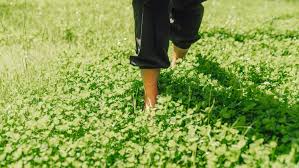As homeowners, gardeners, and landscapers seek more sustainable and environmentally friendly options for lawn care, the concept of a clover lawn has rapidly gained popularity. Clover lawns are not just a trend—they offer real, long-term benefits for those who want a low-maintenance, drought-resistant, and eco-conscious alternative to traditional turfgrass.
What Is a Clover Lawn?
A clover lawn is a yard primarily or partially composed of clover plants rather than standard grass varieties. The most commonly used type is white clover (Trifolium repens), known for its resilience, nitrogen-fixing properties, and soft green foliage. Other varieties, such as microclover, have smaller leaves and blend seamlessly with grass, making them ideal for those who prefer a more traditional-looking lawn with modern benefits.
Benefits of Clover Lawns
1. Natural Fertilization
One of the standout advantages of clover is its ability to fix nitrogen from the atmosphere into the soil. Clover forms a symbiotic relationship with bacteria in its root system that converts atmospheric nitrogen into a form usable by plants. This means your lawn essentially fertilizes itself, reducing or even eliminating the need for synthetic fertilizers.
2. Drought Resistance
Clover has deeper roots compared to most traditional grasses, allowing it to access water that lies beyond the reach of shallow-rooted turf. As a result, clover lawns remain green and lush even during dry spells, making them ideal for drought-prone areas or water-conscious households.
3. Low Maintenance
Unlike grass lawns that need frequent mowing, watering, and fertilizing, clover lawns require far less upkeep. They grow slower, rarely need mowing, and maintain a consistent, attractive appearance. This low-maintenance aspect saves both time and money for homeowners.
4. Pest Resistance
Clover is naturally resistant to many common lawn pests. It also outcompetes weeds, reducing the need for herbicides. Its dense growth pattern prevents sunlight from reaching weed seeds, limiting their ability to germinate.
5. Safe for Pets and Kids
Since clover lawns require fewer chemicals and stay softer underfoot, they are safer for families with children and pets. They also avoid the issue of yellow “dog spots,” as clover is not affected by pet urine the way traditional grasses are.
6. Environmentally Friendly
Clover lawns contribute to biodiversity by attracting pollinators like bees and butterflies. They also reduce carbon emissions by cutting down on the use of lawn equipment, fertilizers, and irrigation.
Drawbacks to Consider
While clover lawns offer numerous benefits, they may not be for everyone. Some homeowners find the appearance of clover less uniform than turfgrass. Clover also bruises more easily than grass, meaning high foot traffic areas might show temporary wear. Additionally, clover goes dormant and turns brown in the winter in many climates, which can be aesthetically unappealing to some.
Pure Clover vs. Clover-Grass Mix
You can choose to plant a pure clover lawn or opt for a blend with traditional grasses. A clover-grass mix offers the best of both worlds: the lush look of a traditional lawn combined with the resilience and low maintenance of clover. Microclover is especially well-suited for these mixes, as its smaller leaves mimic the look of grass more closely and integrate well without dominating.
How to Establish a Clover Lawn
1. Soil Preparation
Before planting clover, prepare your soil by removing existing grass and weeds, then tilling the surface to loosen it. Clover prefers well-draining soil with a pH between 6.0 and 7.0.
2. Seeding
Clover seeds can be sown by hand or with a spreader. For best results, seed in early spring or early fall when temperatures are cooler and rainfall is more consistent.
3. Watering
Water the area lightly after seeding and keep the soil moist until the seeds germinate—usually within 7 to 14 days. Once established, clover needs very little water.
4. Maintenance
After establishment, your clover lawn will require minimal upkeep. Occasional mowing can help it look tidy, but frequent mowing isn’t necessary. Avoid heavy nitrogen fertilizers, as clover already enriches the soil naturally.
Clover Lawn and Lawn Care Services
For those unsure about making the transition from traditional grass to clover, professional lawn care services can help assess your yard, test the soil, and recommend the best approach. Companies like Emerald Lawn & Turf offer tailored services that include eco-friendly lawn solutions such as clover integration. A consultation with a local expert can ease the transition and help you avoid common mistakes, ensuring a healthy, long-lasting clover lawn.
Is a Clover Lawn Right for You?
If you’re looking for a sustainable, low-cost, and environmentally friendly lawn alternative, a clover lawn may be the ideal solution. It requires less water, fewer chemicals, and much less maintenance than traditional lawns. However, it’s important to weigh its aesthetic differences and seasonal appearance when making your decision.
Whether you choose a full clover lawn or a clover-grass blend, the benefits of clover are undeniable. With increasing climate challenges and a growing focus on eco-conscious living, clover lawns are more than just a trend—they’re the future of sustainable landscaping.


Leave a Reply